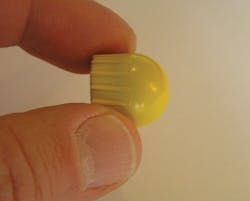The results of a quick Google image search on keywords “smart bullet” include a few cinematic pictures, among others, of a white streak in the sky. A couple of clicks and you’ll discover these pictures are of a microchipped bullet with the technology to hit the target—provided the target is at a known location.
Developed for the military this technology apparently has the ability to penetrate a wall—without fragmentation—and “explode” on the other side. Sounds like a bad day.
While these pictures are attractive the only thing the SRT18 smart round shares with the previously mentioned concept is the microchip. That’s it. Sorry, no mystical white tracer streak. And, of course, there’s the “less-lethal” element to the SRT18 as well.
It seems less-lethal have been getting smarter and smarter with each passing year. At one time the term meant bean bags and rubber bullets, but within a certain range these still had the potential to cause a great amount of injury.
Bring in electricity. Electronic control devices launched a shocking revolution throughout the industry. Suddenly a simple tap of a trigger created an all-familiar warning buzz designed to try and coax suspects to finally “freeze.”
Others pushed electricity further with lasers and rays. Pain rays—as they are commonly referred to—sounded futuristic and extremely attractive without firing one single object. These solutions shine a light onto the target creating a hot/burning sensation, some even including a neauseating feeling.
A different way
About four years ago, Nick Verini, a mechanical engineer and owner of Brighton, Colo.-based SmartRounds Technology (SRT, www.smartrounds.com) looked at the launcher sice of law enforcement’s less-lethal and the military’s non-lethal industries and thought there might be a better way.
The company started with a small pistol-sized launcher designed for law enforcement, says Verini. “We wanted [officers] to be able to carry it in a holster rather than the big M4-type launcher … and then we weren’t happy with the round, the rubber bullets aren’t quite the answer, the pepper balls aren’t quite the answer. So we started looking at what other rounds could you possibly have and we put our thoughts together and we started working on some concepts.”
Their thoughts eventually grew—or compressed—into the SRT18 round.
As mentioned earlier this less-lethal round includes a custom-bult microchip controlling other very small high-tech items: sensors for acceleration, deceleration, and centrifugal force-based generator. All these start to work together immediately from firing. The launcher’s rifling creates the spin which, in turn, powers the chip.
To help put into perspective the size of this chip, the number 18 in SRT18 stands for 18 mm, which puts the whole round at
.68 caliber.
So, it’s a large paintball with a brain?
There are similarities with the paintball and the SRT18. One, both are able to carry a payload. Two, both are made of a brittle plastic decreasing the chance of penetration. The difference comes from how the round breaks, not that it breaks. The paintball uses the impact’s energy to burst. The SRT18 uses the its mechanics inside instead.
Once an impact is detected, according to Verini, sensors expell its payload in about one to two miliseconds, reducing the chance of penetration.
Currently the SRT18 comes available with two payload options. The ShockRound has a small amount of liquified compressed gas expanding upon impact. Which has been designed to attack three of five of the target’s senses. Alternatively, a smart pepper round—currently in developement—would work much like the ShockRound, but with an OC-based gas.
The round itself is D shaped and comes in two types: with the tiny generator (MEMS, micro-electrical mechanical system) and without (MMS, micro-mechanical system). Sensors in the latter detect the acceleration and deceleration rates mechanically.
Launchers
SmartRounds Technology designed the SRT18 round to be used with a DMAG launcher. Still under development, the original protoype is pistol-sized for holster carry. An apparent intent to provide a more compact solution to shotgun-styled (or larger) launchers—yet remain in the pneumatic launcher category. As seen on the SRT Web site “The DMAG pistol is desigend to fill a critical gap in the use of force.”
The site also offers a few specifications:
¦ 6-round 18 mm (.68 caliber) finned projectile magazine
¦ 12-gram disposable CO2 cartidge, 12-shot capacity
¦ Built-in regulator to stabilize muzzle velocity
¦ Made of stainless steel and
aircraft aluminum
SRT is also working on a second DMAG rifle fashioned after the FN Herstal P90 bullpup (as seen on Page 30). The rifle is microprocessor controlled with variable velocity capability. The rifle’s semi-auto, burst and full auto options would most likely make short work of its 40-round magazine.
The potential of having this type of less-lethal D-round launcher in the size of a holstered pistol does ask if this technology would be available to civilians. And then, even further, if someone had license to carry (concealed or no) would they opt for a less-lethal option?
Editor’s Note: At the time of this writing, it is the morning of Friday, July 20. Given the Aurora shooting tragedy, Verini has since then decided to go ahead with the development of a small pistol for his less-lethal projectiles at a projected MSRP of $500.
Specifications
¦ D-shaped 18 mm round (.68 caliber)
¦ Flies at 400 feet per second
¦ Designs include a “Shock” and “smart pepper” payload
¦ 10-foot minimum firing range
¦ 100-yard maximum range (police)
¦ 200-yard maximum range (military)
¦ $5 to $10 per round (MSRP)
¦ Pistol launcher: $500 (MSRP)

Jonathan Kozlowski
Jonathan Kozlowski was with Officer.com, Law Enforcement Technology, and Law Enforcement Product News from August 2006 to 2020.
As former Managing Editor for Officer Media Group, he brought a dedicated focus to the production of the print publications and management of the Officer.com online product and company directory. You can connect with Jonathan through LinkedIn.
Jonathan participated as a judge for the 2019 and 2020 FOLIO: Eddie & Ozzie Awards. In 2012, he received an APEX Award of Excellence in the Technology & Science Writing category for his article on unmanned aerial vehicles (UAVs) in police work, aptly titled "No Runway Needed".



